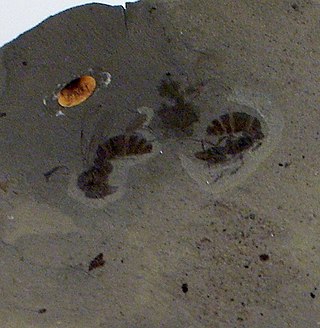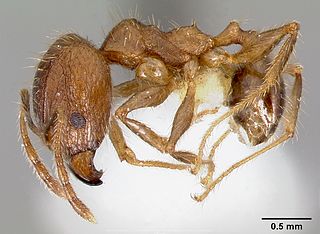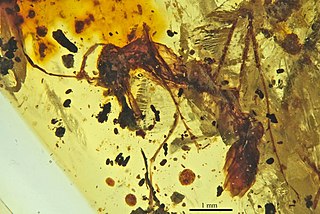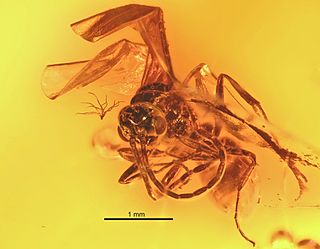
Leptomyrmex, or spider ants, is a genus of ants and a distinctive member of the ant subfamily Dolichoderinae. Commonly known as "spider ants" for their long legs and spider-like movements, these orange and black ants are prominent residents of intact wet forest and sclerophyll habitats throughout their range. One extant species, Leptomyrmex relictus, is known from central Brazil; otherwise, the global distribution of this genus is restricted to eastern Australia, New Caledonia and New Guinea, as well as the nearby Indonesian islands of Aru and Seram.
Pheidole bula is a species of ant in the genus Pheidole. It was discovered in Fiji, and described by E. M. Sarnat in 2008.
Pheidole simplispinosa is a species of ant native to the forests of Fiji.

Ypresiomyrma is an extinct genus of ants in the subfamily Myrmeciinae that was described in 2006. There are four species described; one species is from the Isle of Fur in Denmark, two are from the McAbee Fossil Beds in British Columbia, Canada, and the fourth from the Bol’shaya Svetlovodnaya fossil site in Russia. The queens of this genus are large, the mandibles are elongated and the eyes are well developed; a stinger is also present. The behaviour of these ants would have been similar to that of extant Myrmeciinae ants, such as solitary foraging for arthropod prey and never leaving pheromone trails. The alates were poor flyers due to their size, and birds and animals most likely preyed on these ants. Ypresiomyrma is not assigned to any tribe, and is instead generally regarded as incertae sedis within Myrmeciinae. However, some authors believe Ypresiomyrma should be assigned as incertae sedis within Formicidae.

Tatuidris, or armadillo ant, is a rare genus of ants consisting of a single species, Tatuidris tatusia. The ants are small in size and inhabit the leaf litter of Neotropical forests in Central and South America, from Mexico to Brazil. Workers are ferruginous-colored to dark red and present a distinctive morphology, consisting of a shield-like head with a broad vertex, ventrally-turned heavy mandibles which do not overlap at full closure, and unique among ants – an antenna socket apparatus sitting upside-down. Little is known about the biology of the ants, but they are likely nocturnal and specialist predators.

Brownimecia is an extinct genus of ants, the only genus in the tribe Brownimeciini and subfamily Brownimeciinae of the Formicidae. Fossils of the single identified species, Brownimecia clavata, are known from the Middle Cretaceous of North America. The genus is one of several ants described from Middle Cretaceous ambers of New Jersey. Brownimecia was initially placed in the subfamily Ponerinae, until it was transferred to its own subfamily in 2003; it can be distinguished from other ants due to its unusual sickle-like mandibles and other morphological features that makes this ant unique among the Formicidae. The ant is also small, measuring 3.43 millimetres (0.135 in), and a stinger is present in almost all of the specimens collected. The morphology of the mandibles suggest a high level of feeding specialization.

Lordomyrma is a genus of ants in the subfamily Myrmicinae.

Ravavy is a Malagasy genus of ant in the subfamily Dolichoderinae containing the single species Ravavy miafina.

Zigrasimecia is an extinct genus of ants which existed in the Cretaceous period approximately 98 million years ago. The first specimens were collected from Burmese amber in Kachin State, 100 kilometres (62 mi) west of Myitkyina town in Myanmar. In 2013, palaeoentomologists Phillip Barden and David Grimaldi published a paper describing and naming Zigrasimecia tonsora. They described a dealate female with unusual features, notably the highly specialized mandibles. Other features include large ocelli, short scapes, 12 antennomeres, small eyes, and a clypeal margin that has a row of peg-like denticles. The genus Zigrasimecia was originally incertae sedis within Formicidae until a second species, Zigrasimecia ferox, was described in 2014, leading to its placement in the subfamily Sphecomyrminae. Later, it was considered to belong to the distinct subfamily Zigrasimeciinae.

Tyrannomyrmex legatus is a tropical Old World species of ants in the subfamily Myrmicinae. It is only known from a single worker from Sri Lanka. Gynes and males are unknown.

Pheidole fervens is a species of ant in the subfamily Myrmicinae. Pheidole fervens, described from Singapore, is a widespread invasive species and could be native to the Oriental or the Oceanic region.
Lordomyrma vanua is a species of ant in the subfamily Myrmicinae.
Pheidole loki is a species of ant in the subfamily Myrmicinae.

Gnamptogenys triangularis is a Neotropical species of ants in the subfamily Ectatomminae. Native to the forests of South and Central America, G. triangularis is a predatory ant that feeds on millipedes. In its native range, this species is known from Buenos Aires, Argentina in the south to Costa Rica in the north, with records from eight countries in South America, and two countries of Central America. The first records of G. triangularis outside its native range came from Florida beginning in 1985 and Alabama in 1996.
Pristomyrmex tsujii is a species of ant in the genus Pristomyrmex. Known from Fiji, where they are widely distributed but rarely encountered. The species has a discrete ergatoid queen caste that is intermediate between a worker and an alate queen.

Pseudectatomma is an extinct genus of ants in the formicid subfamily Ectatomminae described by from fossils found in Europe. The genus contains two species dating from the Eocene, Pseudectatomma eocenica and Pseudectatomma striatula.

Myanmyrma is an extinct genus of ants not placed into any Formicidae subfamily. Fossils of the single known species, Myanmyrma gracilis, are known from the Middle Cretaceous of Asia. The genus is one of several ants described from Middle Cretaceous ambers of Myanmar.

Messelepone is an extinct genus of ants in the formicid subfamily Ponerinae described from fossils found in Europe. M. leptogenoides is the only species assigned to the genus, which is one of several Lutetian Ponerinae genera.

Pachycondyla succinea is an extinct species of ant in the formicid subfamily Ponerinae described from fossils found in Europe. P. petrosa is one of three middle Eocene Pachycondyla species found in Baltic amber.

Linguamyrmex is an extinct genus of ant in the formicid subfamily Haidomyrmecinae, and is one of only nine genera placed in the subfamily Haidomyrmecinae. The genus contains three described species, Linguamyrmex brevicornis, Linguamyrmex rhinocerus, and the type species Linguamyrmex vladi all known from Late Cretaceous fossils found in Asia.















